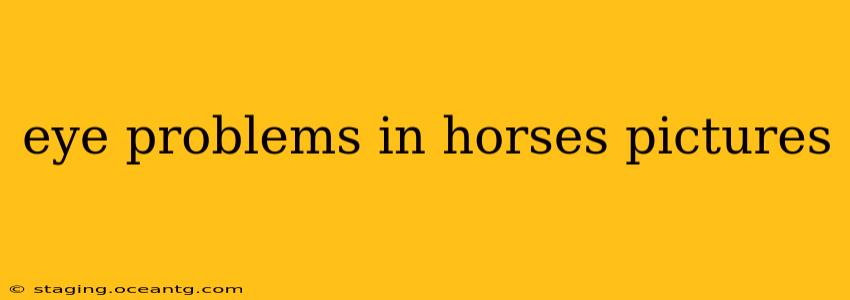Equine ophthalmology is a specialized field, and recognizing eye problems in horses can be challenging even for experienced horse owners. This guide provides a visual overview of common equine eye issues, emphasizing the importance of prompt veterinary attention. Early diagnosis is crucial for effective treatment and preventing vision loss. Note: This article is for informational purposes only and does not substitute professional veterinary advice. Always consult your veterinarian for any concerns about your horse's health.
What are some common eye problems in horses?
Horses, like humans, are susceptible to a range of eye conditions. Some of the most prevalent include:
-
Conjunctivitis (Pink Eye): This inflammation of the conjunctiva (the membrane lining the eyelid and covering the sclera) is often characterized by redness, swelling, and discharge. The discharge can be watery, mucoid (sticky), or purulent (pus-like), depending on the cause (viral, bacterial, or allergic).
-
Uveitis: This serious inflammation affects the uvea, the middle layer of the eye encompassing the iris, ciliary body, and choroid. It can present with pain, redness, cloudiness of the cornea, and reduced vision. Uveitis can have various underlying causes and requires prompt veterinary attention.
-
Corneal Ulcers: These are wounds on the cornea, the transparent front part of the eye. They can range in severity from minor abrasions to deep, penetrating ulcers. Signs include pain, squinting, tearing, and a cloudy or opaque area on the cornea.
-
Cataracts: These are opacities (cloudiness) in the lens of the eye, obstructing light passage and impairing vision. They often appear as a whitish or grayish film over the pupil. Cataracts can develop gradually and eventually lead to blindness.
-
Equine Recurrent Uveitis (ERU): This is a chronic inflammatory condition affecting the uvea, often recurring in affected eyes. It can lead to significant vision loss and even blindness if not managed properly.
-
Entropion: This is an inward turning of the eyelid, causing the eyelashes to rub against the cornea, leading to irritation, inflammation, and ulceration.
-
Ectropion: This is an outward turning of the eyelid, resulting in inadequate tear film protection and increased risk of dryness and infection.
What do eye problems in horses look like? (Pictures would be included here if this were a visually rich blog post. Consider searching online for images to supplement this information.)
Unfortunately, I can't display images directly in this text format. However, a thorough image search using terms like "horse conjunctivitis," "horse corneal ulcer," "horse cataract," or "horse uveitis" will yield numerous examples. Pay close attention to the color, consistency of any discharge, pupil size and reactivity to light, and the overall appearance of the eye and surrounding tissues. Abnormal swelling, redness, cloudiness, squinting, and excessive tearing are all significant warning signs.
How can I tell if my horse has an eye problem?
Several signs indicate potential eye issues:
- Squinting or holding the eye closed: This is a common sign of pain or discomfort.
- Excessive tearing or discharge: The color and consistency of discharge can provide clues to the underlying cause.
- Cloudiness or opacity in the cornea: This suggests a corneal ulcer or other problem.
- Changes in pupil size or reactivity to light: Abnormal pupil size or lack of response to light warrants immediate veterinary attention.
- Headshaking or rubbing the eye: These behaviors often indicate irritation or pain.
- Visual impairment: Notice any changes in your horse's behavior or ability to navigate its surroundings.
What should I do if I suspect my horse has an eye problem?
Immediate veterinary attention is crucial. Do not attempt to self-treat your horse's eye problems. Your veterinarian can properly diagnose the condition and recommend the most appropriate treatment plan. Delaying treatment can lead to permanent vision loss or other complications.
Are there any specific breeds more prone to eye problems?
While various breeds can be affected, certain predispositions exist. For example, some breeds seem to have a higher incidence of specific conditions like ERU. Consult your veterinarian to discuss breed-specific risks.
What are the treatment options for eye problems in horses?
Treatment varies depending on the specific condition. It may include topical medications (eye drops or ointments), systemic medications (oral or injectable), surgical intervention, or a combination of approaches. Your veterinarian will determine the best course of action based on a thorough examination and diagnosis.
This information provides a general overview of eye problems in horses. Remember, the accurate diagnosis and treatment of equine eye conditions require the expertise of a veterinarian. Early detection and prompt veterinary intervention are vital for the best possible outcome for your horse.
